#kunstakademie Düsseldorf
Explore tagged Tumblr posts
Text
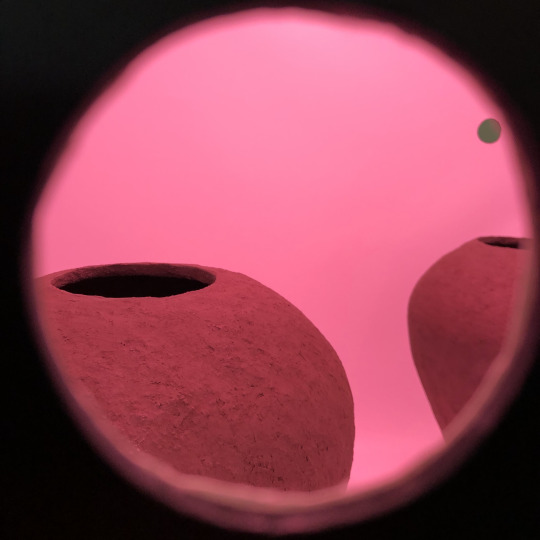
220219
·
#photographers on tumblr#original photographers#concept photography#kunstakademie düsseldorf#art#installation#rundgang#interfoto#josch schlegel
6 notes
·
View notes
Text
Marta Klonowska: Vom Eigenleben der Kreaturen: Hamburg vom 25.02. bis 04.05.2024
Die polnische Künstlerin Marta Klonowska fertigt faszinierende Tierskulpturen aus zerbrochenem, farbigem Glas. Ihre tierischen Werke können vom 25. Februar bis 04. Mai 2024 im Glasmuseum der Achilles-Stiftung an der Fuhlsbüttler Straße 415a in Hamburg bewundert werden. Den Reiz an zerbrochenem Glas entdeckte Marta Klonowska per Zufall. Es war eine kaputte Glasflasche, die sie während ihrer Zeit…
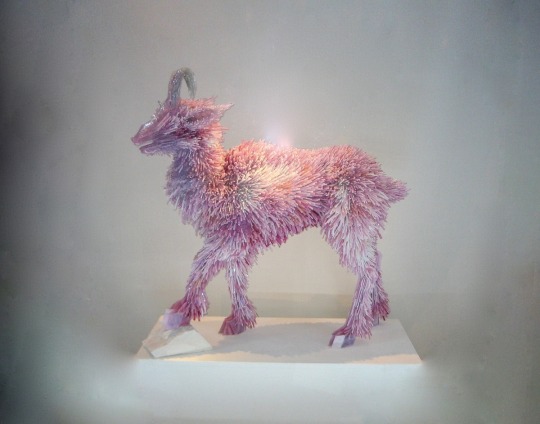
View On WordPress
#Achilles Stiftung#angewandte Kunst#Design#Glas#Glasscherben#Hamburg#Handwerkskunst#Inspiration#Kunst#Kunstakademie Düsseldorf#Kunsthandwerk#Marta Klonowska#tierfiguren#Tierskulpturen
0 notes
Text
Private Umbrüche…
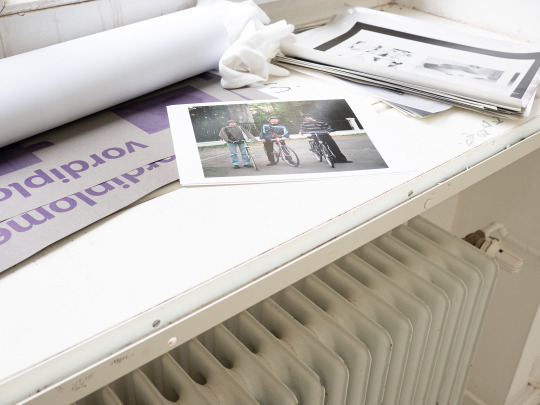
.
Kottan war in den letzten Tage nicht ganz bei der Sache, denn W.'s Tage in Leipzig waren gezählt. Das Vordiplom in der Tasche, stand ein Umzug an, in dessen Zuge sich Kreise schließen würden: W. wechselt an die Hochschule, die sich in Rufweite der Düsseldorfer Altstadt und Kunsthalle befindet – der die Kollegen erst kürzlich einen Besuch abgestattet hatten!
Vor ein paar Wochen noch hatten Schrammel und Schremser Kottan mit ihrem Wochenend-Trip in die deutsche Stadt am Rhein so verrückt gemacht, dass er überlegt hatte, sich der kleinen Reisegruppe anzuschließen. Letztlich ging es sich nicht aus wegen dieser verdammten Horrak-Geschichte…
Wenigstens haben der Herr Major und Ilse das vergangene Wochenende in Leipzig genossen und W. samt Spar-Hausstand am Sonntag mit in die alte Heimat genommen. Während W. erleichtert schien, erstmal in heimatliche Gefilde zurückkehren zu können, kamen in Kottan seltsame Gefühle auf: Die sächsische Metropole war ihm in den letzten zwei Jahren fast unbemerkt ans Herz gewachsen, vor allem die dortige Fahrradkultur ist ihm sehr sympathisch – so gut wie keine dicken Männer mit Reichweitenangst auf deswegen genauso dicken SUV-Pedelecs, kaum Helme und die Damen fast durchweg mit "Herrenrahmen" (sagt man alles heute nicht mehr – es gibt hohen und tiefen Einstieg bzw. 'Wave'-Rahmen!). Und alle in sehr engagiertem Tempo. Ein schönes Gewusel hats dort in dieser Stadt!
Am Freitag Abend haben sich die beiden Besucher aus Wien in der Hochschule die Ausstellung der (Vor-)Diplomanten angesehen und ein paar Biere mit den Künstlern gezischt, das war ein sehr schöner Abend an einem Ort der staatlich unterstützten Freiheit. In Sachsen! A Waunsinn! Kottan und Ilse sponnen leicht angeflutet ganz motivierende Zukunftsvisionen durch, aber das ist eine andere G'schicht…
.
#dezernat-4#inside kottan#kottan privat#leipzig#hgb#düsseldorf#kunstakademie düsseldorf#deutschsprachiger text#deutscher text#fiktion#hgb leipzig
1 note
·
View note
Text
Das Deutsche Fotoinstitut in Düsseldorf – Zukunft der Fotografie sichern
Die Fotografie spielt eine zentrale Rolle in Kunst, Kultur und Wissenschaft. Doch trotz ihrer Bedeutung gibt es in Deutschland bisher kein zentrales Institut zur Erforschung, Erhaltung und Vermittlung des fotografischen Erbes. Genau hier setzt das geplante Deutsche Fotoinstitut (DFI) in Düsseldorf an. Mit Unterstützung der Landeshauptstadt Düsseldorf, des DFI e.V. und der Photographischen…
#Albert Renger-Patzsch#Andreas Gursky#art#Ausstellung#bekannter fotograf#Boris Becker#Candida Höfer#Deutsche Fotoinstitut#DFI#DFI e.V.#Diane Arbus#Duesseldorf#Eugène Atget#Fotoausstellung#Fotograf Duesseldorf#Fotografie#Fotografie Sammlung#Fotografie-Freund#Fotograph#Fotos#Hugo Erfurth#Jim Dine#Joachim Brohm#Judith Joy Ross#Karl Blossfeldt#Kunst#Kunstakademie#Kunstakademie-Duesseldorf#Landeshauptstadt Düsseldorf#Martin Rosswog
0 notes
Text
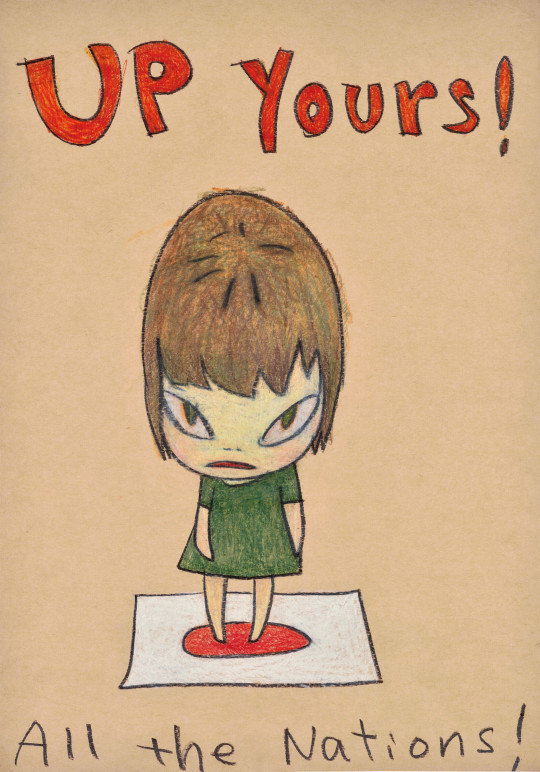
"UNTITLED" // 2007 YOSHITOMO NARA 奈良 美智 [coloured pencil on coloured paper | 16 ½ x 11 5/8"]
With her short cropped hair, dark green dress and rebellious energy, the girl in Untitled (2007) emits the youthful defiance that has come to typify works by Yoshitomo Nara. [...]
"He is widely celebrated for his paintings and coloured pencil drawings of juvenile, cartoonish characters with large gazing eyes and endearing personalities. They inhabit imagined and insouciant paper worlds, brandish absurd objects and props—knives, sprouts, cigarettes, and electric guitars—and express a wide range of capricious, childlike emotion. Stern and somewhat sulky, our subject hovers in indeterminate space. She stands upon a Japanese flag with her small feet positioned perfectly over its crimson sun. Emblazoned around her miniature figure are the words ‘Up Yours!’, and, ‘All the Nations!’. As an advocate of peace, questions of nationhood, conflict and world politics weave through Nara’s art in such pithy phrases and symbols. Exhibited at the Centro de Arte Contemporáneo de Málaga—the first show of the artist’s work in Spain in 2007-2008—the present work was one of twenty coloured pencil drawings hung along the final wall of the gallery.
Born in 1959 in Japan’s rural Aomori Prefecture, Nara’s youth was marked by his country’s rapid post-war economic development and an influx of Western pop-culture, from Disney animation to punk and rock and roll. The artist expresses heartfelt nostalgia for the retro media—record-sleeves and comic books—that offered escapism from an otherwise solitary childhood. ‘Of course if you think back to the ’70s,’ he says, ‘information moved very differently. There was no Internet obviously and even the release date of albums in Japan could be delayed as much as six months … I would just sit there, listen to the music, look at the art on the cover and I think I really developed my imagination through that’ (N. Hegert, ‘Interview with Yoshitomo Nara,’ Artslant, 18 September 2010). This sensitivity to the worn, tactile quality of objects is triumphant in his art today and distinguishes him from the likes of Takashi Murakami and his Superflat movement. Untitled bears the enlivening traces of artist’s hand, present in the rough ‘outside-the-line’ scribbles that imply the girl’s messy hair. Bracketed with Nara’s unfiltered, handwritten text, the image feels distinctly personal, like a secret note exchanged between friends.
As early as his time at Aichi Prefectural University of Fine Arts in the 1980s, Nara began to draw onto envelopes, cardboard, and scraps of found paper. He continued these explorations at the prestigious Kunstakademie Düsseldorf where, under the tutorship of German Neo-Expressionist painter A. R. Penck, he was encouraged to work fluidly between painting and drawing. ‘I [loved] to draw every day and the scrawled sketches, never shown to anybody, started piling up’, Nara has said. ‘Like journal entries reflecting the events of each day, they sometimes intersected [with] memories from the past. My little everyday world became a trigger for the imagination, and I learned to develop and capture the imagery that arose’ (Y. Nara, ‘Nobody’s Fool’, in N. Miyamura and S. Suzuki (eds.), Yoshitomo Nara: The Complete Works, Volume 1: Paintings, Sculptures, Editions, Photographs 1984-2010, San Francisco 2011, p. 43). Mischievous, cute, and quietly ferocious, the present work attests to the enduring appeal of Nara’s little rebels." — via Christie's
151 notes
·
View notes
Text
Artists I think everyone should look at
Part Two
I hath returned with more correct opinions 💯
John William Waterhouse
England, 1849-1917
Amongst the more well known on this list is Waterhouse: with works in the Academic style and Pre-Raphaelite Brotherhood's style. Waterhouse frequently depicted young women in his works, as well as Greek myths, or Arthurian legend.
He is responsible for well-known paintings such as Medea, Ophelia, Diomedes, Ulysses and the Sirens, etc.


(Left) Sleep and his Half-brother Death, 1874 | (Right) The Lady of Shalott, 1888
Henriëtte Ronner-Knip
Netherlands, 1821-1909
Knip is best known for her animal paintings, cats, in particular. Her family seems to have each had a "niche" regarding artwork: her mother painted birds, her Aunt painted flowers, her daughter fruits/flowers.
Knip was the first woman to become an "active member" to Arti et Emicitae, a Dutch arts society. In 1887, she was awarded the Order of Leopold and in 1901, became a member of the Order of Orange-Nassau.

Three Kittens, c. 1840
Ivan Kramskoy
Russia, 1837-1887
Kramskoy was a leader of the Peredvizhniki (trans. "The Wanderers"), an art movement centered around realism. Many of his portraits of public figures are compositionally simple and filled with character.
His works featured expressiveness of the individual, showing personality and complex emotion. He was considered eccentric for not charging money for expensive frames.


(Left) Portrait of an Unknown Woman, 1883 | (Right) The Forester, 1874
Franz Xaver Winterhalter
Germany, 1805-1873
Winterhalter was renowned for his flattering portraits of the upper-class and royalty.
Though of poor descent, Winterhalter studied at the Academy of Arts in Munich with a sponsorship and stipend. Through the Grand Duchess of Baden, he became known to the socially elite.


(Left) The Empress Eugénie Surrounded by her Ladies in Waiting, 1885 | (Right) Portrait of Alexandra of Denmark
Elisabeth Jerichau-Baumann
Poland/Denmark, 1819-1881
Baumann began her career at nineteen studying at Kunstakademie Düsseldorf, at the time a highly respected fine arts academy. She moved around a bit; many of her paintings depict various locations, usually of people in everyday local life.
She was twice represented at the World Fair in Paris, exhibited work in London, where Queen Victoria requested a private presentation of her work, and found great success abroad throughout her career.


(Left) An Egyptian Pot Seller at Gizeh, 1878 | (Right) En såret dansk kriger, 1865
4 notes
·
View notes
Text
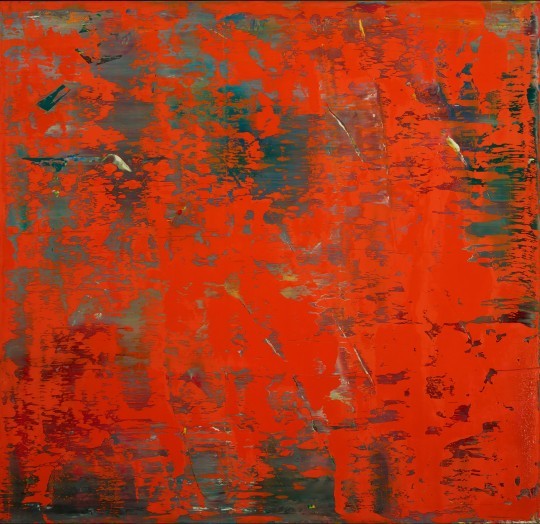
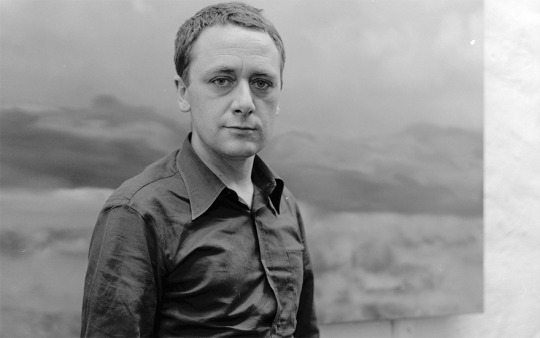
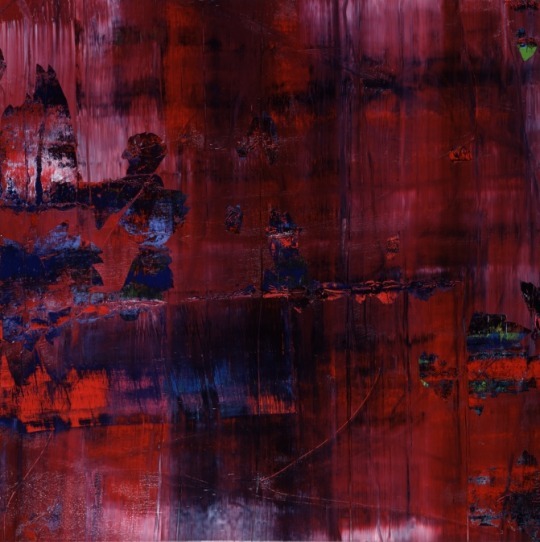
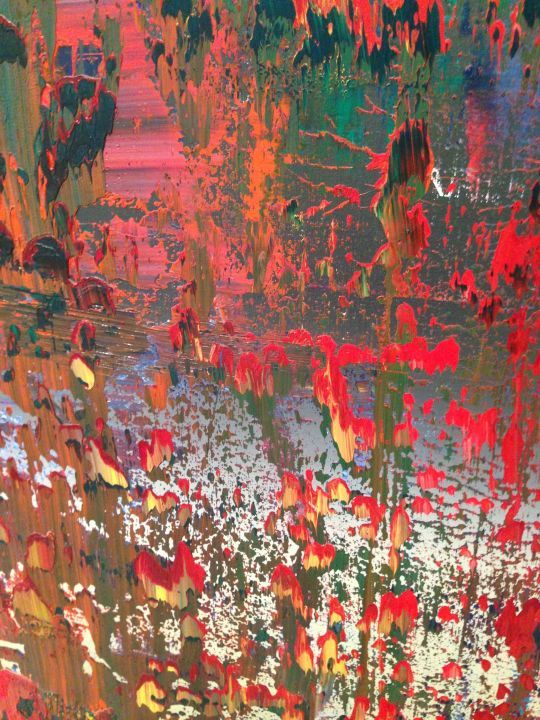
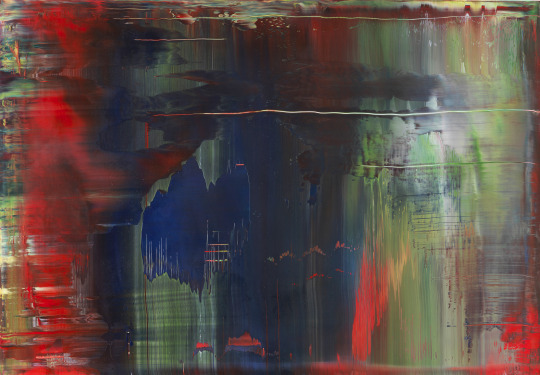
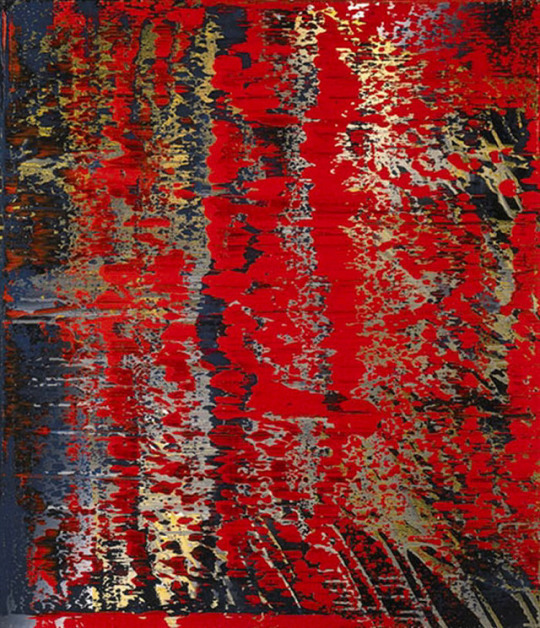
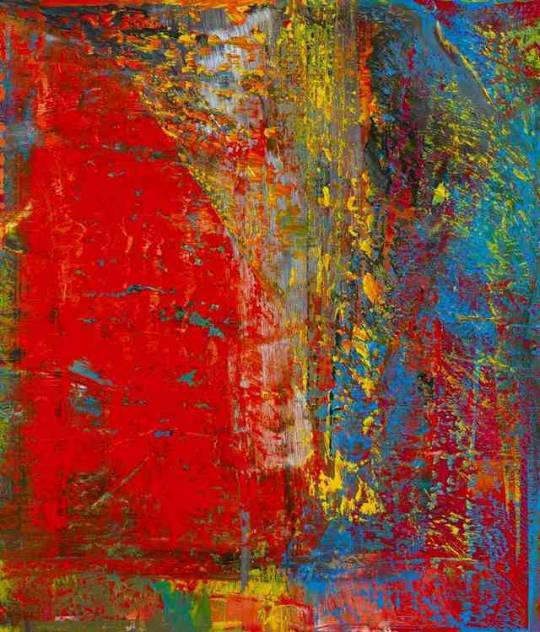

Gerhard Richter was born in 1932 in Dresden, Germany, during the rise of the National Socialist German Workers' Party, or the Nazi Third Reich. Notably, some of Richter's relatives were directly involved in the Nazi movement, namely his father, a schoolteacher, and an uncle. Richter's mother, the daughter of a concert pianist, encouraged her son's early talent for draftsmanship. In 1948, at the age of 16, Richter quit his formal education and took up an apprenticeship as a set painter for the theater. The wake of war proved traumatic for Richter: two of his uncles had been killed in action, and his father had lost his employment. This family turmoil, coupled with the artist's early artistic training under postwar communist-driven ideology, eventually led Richter to seek his creative inspiration in nature over any political or religious affairs or philosophies.
Beginning in 1951, Richter studied at the Kunstakademie, Dresden, where he painted murals and political banners commissioned by state-owned businesses. During this time, the East German communist regime imposed a Social Realist style on all practicing artists; this policy effectively turned art to the service of political propaganda. In keeping with this development, the government banned exhibitions of American Pop art and Fluxus. These circumstances severely limited Richter's fledgling artistic style, as he was instructed to paint only landscapes in a manner heavily informed by pastoral romanticism.
Richter married Marianne Eufinger in 1957, and the couple celebrated the birth of a daughter, Betty, in 1966. Two years later, during a visit to West Germany in 1959, Richter discovered the work of contemporary artists Jackson Pollock and Lucio Fontana. Pollock's uninhibited splashes of color across canvas had a profound impact on Richter, provoking him to reflect on his own artistic ideology. Indeed, Richter began to question how a realist style did not seem to capture the energy, sense of truth, and spirit of artistic liberation that he observed in the abstract work of his American and European contemporaries. Supposedly "realistic", his work seemed to fail to reflect the underlying, tumultuous nature of reality itself.
In 1961, just prior to the government's official completion of the Berlin Wall, Richter moved to Düsseldorf. Once again enrolling at the local Kunstakademie, Richter intended to work in a more uninhibited, avant-garde manner; in the process of rethinking his approach to art making, he purposely destroyed many of his early paintings from the 1950s and the 1960s.
Continue reading https://www.theartstory.org/artist/richter-gerhard/
64 notes
·
View notes
Text
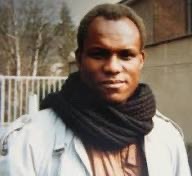
Henry Nkole Tayali (November 22, 1943 – July 22, 1987) was a multi-lingual painter, sculptor, printmaker, raconteur, and lecturer. He has been described as Zambia’s most famous painter.
He was born to Edward Nkole Tayali and Esnati Mumba Tayali (née Chola) in Serenje in the British Colony of Northern Rhodesia, a town near the site of the Nsalu 12,000-year-old rock and cave paintings. His father emigrated from Northern Rhodesia to work in Bulawayo in Southern Rhodesia, ending up in the Department of Housing and Amenities.
He was awarded a Zambian Government scholarship to study at Makerere University in Kampala, where he graduated with a BA. He returned to Zambia and started work at the University of Zambia where he joined the Institute of African Studies in Lusaka as a lecturer in African art and as a University Artist. He got a German Academic Exchange Service scholarship to study for an MFA at the Staatliche Kunstakademie Düsseldorf. He was the first recipient of the DAAD to be selected from south of the equator.
He married Regina Mary Birungi Kivubiro (1971-76) and they had a son. He married Rosemary Kuluwa and they had two children. His son Rhodrick is an artist and interior designer by training and a graduate of the Fachhochschule Aachen and is an accomplished artist. #africanhistory365 #africanexcellence
2 notes
·
View notes
Text
BASIC FORMS > BERND & HILLA BECHER
*CLÁSSICOS

Os alemães Bernd (Bernhard,1931-2017) e Hilla Becher (1934-2015) foram fotógrafos que juntos produziram uma extensa documentação tipológica de estruturas industriais na Alemanha e em outros países da Europa e nos Estados Unidos. Suas imagens têm um caráter que chamamos de "straight" ou seja sem firulas ou maneirismos, observando sempre um plano direto, em preto e branco, que serviram como estudos do que eles chamaram de "Escultura Anônima", um registro das relíquias arquitetônicas em extinção, como minas de carvão, siderúrgicas, caixas de água, silos de grãos e tanques de gás entre outras construções.
A importância da dupla pode ser avaliada pela Bienal de Veneza de 1990 que concedeu o Leão de Ouro da Escultura para eles. No pavilhão alemão daquele ano, foram expostas as séries de instalações arquitetônicas, cujo o mainstream da pesquisa da arquitetura não dava muita importância. Esculturas, no entanto, os Bechers nunca criaram. Eles simplesmente fotografaram as estruturas industriais abandonadas. Sem eles, realmente teriam continuado anônimas, no paradoxo do título de suas séries. Entre os inúmeros livros publicados, encontramos a reedição de seu Basic Forms ( Prestel London, 2020), originalmente publicado em 2014 pela Schirmer/Mosel Verlag Munich como Basic Forms- of Industrial Buildings, uma síntese de 40 anos de trabalho pelo mundo em busca da representação de tipologias e topografias peculiares.

Hilla e Bernd conheceram-se quando estudavam pintura na Kunstakademie Düsseldorf (Academia de Belas Artes de Dusseldorf) instalada na cidade dividida pelo rio Reno, com a Altstadt (Cidade Antiga) na margem oriental e as modernas áreas comerciais. Seguiram um romance que os levou a uma carreira colaborativa. Eles contam: “Tomamos consciência de que estes edifícios eram uma espécie de arquitetura nômade que tinha uma vida comparativamente curta – talvez 100 anos, muitas vezes menos, e depois desaparecem. Parecia importante mantê-los de alguma forma e a fotografia parecia a forma mais adequada.” Seus métodos e técnicas de trabalho influenciaram uma geração de fotógrafos hoje conhecida como Escola de Düsseldorf, que inclui nada menos que os consagrados alemães Andreas Gursky, Thomas Struth, Thomas Ruff e Candida Höfer. Suas obras estão incluídas nas coleções do Art Institute of Chicago, do Museum of Modern Art de Nova York, da National Gallery of Art de Washington, D.C. e da Tate Gallery de Londres, entre inúmeras importantes instituições do mundo.
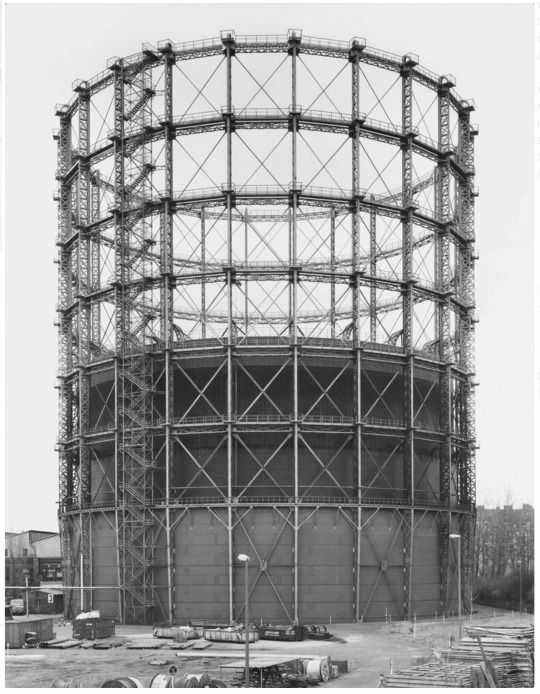
O inventário fotográfico destas estruturas industriais é sem dúvida uma das realizações mais interessantes e significativas da produção fotográfica dos séculos XX e XXI. Apoiando-se na ideia da tipologia e uma visão comparativa, o casal entrou sistematicamente no assunto revelando constantes variações destes complexos que nunca eram chamados de "arquitetônicos" muito menos interessantes para a arte estabelecida à época do início desta produção ( anos 1960 aos 2000) construindo uma impressionante coleção de séries tipológicas, criando assim uma inestimável enciclopédia fotográfica sobre a cultura industrial de uma época final que combina a taxonomia científica com o empirismo estético. O levantamento mostrado em Basic Forms, segundo seus editores, ilustra ambos: as "formas básicas" da arquitetura industrial anônima e o conceito estético da fotografia de Bernd e Hilla Becher.
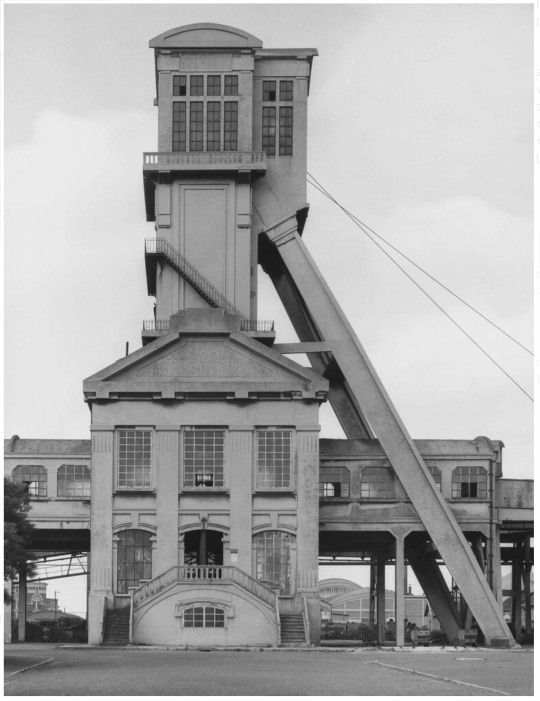
Basic Forms contém um texto instigante do belga Thierry de Duve, professor visitante de Arte Moderna e Teoria da Arte Contemporânea, nas universidades de Lille III e Sorbonne, ambas na França, além de crítico de arte e curador, como do Pavilhão belga Na Bienal de Veneza de 2003, e autor de livros importantes como "Pictorial Nominalism; On Marcel Duchamp's Passage from Painting to the Readymade (University of Minnesota Press, 1991),"Bernd and Hilla Becher" (Schirmer Art Books, 1999), entre dezenas de outros, publicados na Inglaterra, Alemanha e Estados Unidos.

As fotografias são feitas com uma câmera que utiliza negativos no formato grande 20X25cm, no início da manhã, em dias nublados, para eliminar sombras e distribuir a luz de maneira uniforme. O tema é centrado e enquadrado frontalmente, com suas linhas paralelas dispostas em um plano o mais próximo possível de uma elevação arquitetônica. Nenhum ser humano e nenhuma nuvem ou pássaro no céu interferem na rigidez. A imagem não transmite nenhum humor, nem o menor toque de fantasia que perturbe sua neutralidade ascética. Raramente a recusa do Fotografte ( o fotografado) subjetivo é feita e a Sachlichkeit (Objetividade) da lente da câmera foi perseguida de forma tão sistemática, reflete Thierry de Duve.
Considerando a possibilidade de uma fotografia ser totalmente desprovida de estilo, a dos Bechers poderia ser entendida deste modo. Um trabalho que segundo a crítica pertence à tradição arquivística da fotografia na qual o francês Eugène Atget (1857-1927) e o alemão August Sander (1876-1964) – fotógrafos que fizeram questão de não serem artistas e se destacaram, embora hoje sejam considerados como tais. "As fotos de Bernd e Hilla poderiam ser descritas como puros documentos se não houvesse algo que nos impedisse de colocá-las, sem mais delongas, na categoria da foto documental." diz Duve.

O crítico em seu texto explora o ideal da imagem conceitual e recorre a um provérbio chinês apócrifo: “Quando o homem sábio aponta para a lua, o tolo olha para o seu dedo”. No caso dos fotógrafos, o tolo olha para a fotografia e o sábio para o que esta mostra. "O tolo pergunta por que essas imagens são “arte”, enquanto o sábio vê nelas um testemunho indiscutível do mundo real. "No entanto, o mais sábio dos homens sábios é um tolo, porque para saber que o dedo está apontando para a lua, ele deve primeiro olhar para o dedo. É um dos paradoxos da fotografia que um elemento giratório balance incessantemente o espectador de uma representação para um uso estético da imagem e vice-versa.
Mesmo que os Bechers tenham profundo conhecimento da sua profissão é difícil chamá-los de fotógrafos. No mundo da arte onde os seus trabalhos circulam, onde é visto e vendido, as pessoas os descrevem como artistas, acrescentando ocasionalmente “que fazem uso da fotografia”. Para de Duve, "a obra do casal abriga uma emoção contida, melancolia sem nostalgia, dor histórica, guerras de classes travadas ou sustentadas, admiração pela arte multifacetada do engenheiro, lucidez, dignidade, respeito pelas coisas, humildade e auto-anulação que só tenho uma coisa a dizer sobre isso : esta é uma arte genuinamente grande, daquelas que não tem necessidade de ter o seu nome protegido ao ser colocada num museu, porque já pertence à nossa memória coletiva."

As fotografias, nas paredes de um museu ou galeria são “arte”. Inseridas nas páginas deste livro fazem fronteira com o documento etnográfico, mas em ambos os casos, são fotografias e não pinturas ou gravuras. Mostram aquilo que a luz gravou em sua superfície. O filósofo americano Charles Sanders Peirce (1839-1914) um dos pioneiros da Semiótica - classificou a fotografia como um sinal por conexão física que, como fumaça ou pegadas na neve, é ao mesmo tempo um índice do objeto ao qual se refere e um indicador apontando para ele. É a existência real dos seus referentes, porque como eles estão relacionados por um nexo causal que pode operar em contiguidade espaço-temporal ou em contiguidade quebrada e assemelham-se aos seus referentes. Aqueles que figuram na classificação de Peirce tanto como ícones quanto como índices. Esse é o caso da fotografia. Faça uma fotografia de uma torre de água, no sentido de representá-la e mostre-a, diz o crítico. Ela é a representação de como faria um desenho com uma ligeira diferença que é a causalidade fotoquímica.
O projeto de quase uma vida de Bernd e Hilla Becher ao documentar a paisagem industrial do nosso tempo assegura sua posição no cânone dos fotógrafos do pós-guerra. Ao reunirem ao mesmo tempo arte conceitual, estudo tipológico e documentação topológica, certamente nos aproxima da grande mostra New Topographics Photographs of a Man-Altered Landscape, no museu de fotografia da George Eastman House, em Rochester, Nova York, entre outubro de 1975 e fevereiro de 1976, com curadoria de William Jenkins, na qual os dois tiveram importante papel na ruptura da história da fotografia e as representações não tradicionais da paisagem. A visão romântica e transcendente deu lugar às indústrias austeras, a expansão suburbana e cenas cotidianas, elaboradas por fotógrafos como eles e seus companheiros da mostra original: os americanos Robert Adams, Lewis Baltz (1945-2014), Joe Deal (1947-2010) , Frank Gohlke, Nicholas Nixon, John Schott, Stephen Shore e Henry Wessel (1942-2018).

Sintetizadas a um estado essencialmente topográfico e transmitindo quantidades substanciais de informação visual, mas evitando quase inteiramente os aspectos de beleza tradicional, emoção e opinião são características que resumem estes trabalhos. Entretanto, ao olhar as formas capturadas pelos Bechers fica difícil não realizar a beleza (melancólica) e ímpar contida- principalmente pelo seu caráter tipológico nelas representadas- ao incorporaram igualmente uma precisão técnica excepcional, expressa nos negativos de grande formato e filmes lentos.
O livro Bernd & Hilla Becher, Life and Work (MIT Press, 2006) de Susanne Lange, historiadora da fotografia, uma bem documentada biografia, discute as dimensões funcionalistas e estéticas do tema do casal, em especial a tipologização na obra deles, que considera uma reminiscência dos esquemas classificatórios dos naturalistas do século XIX e o estilo de construção industrial anônimo preferido pelos arquitetos alemães. Ela argumenta que os tipos de edifícios industriais impõem-se à nossa consciência como a catedral o fez na Idade Média, e que as fotografias do casal - que à primeira vista parecem registar apenas uma paisagem em extinção - servem para examinar esta configuração das nossas percepções.

Em 1922, se pergunta Thierry de Duve, quando o arquiteto suíço Le Corbusier (Charles-Edouard Jeanneret-Gris,1887-1965) procurava o caminho para uma nova arquitetura, ou antes, em 1919 quando o arquiteto alemão Walter Gropius (1883-1969) fundou a Bauhaus, quais eram os seus referentes, que modelos citavam para uma arquitetura ainda por nascer? Ele responde: "O mais conhecido foi tirado da América industrial e celebrado tanto pelo primeiro quanto o segundo: o silo de grãos. Se você adicionar armazéns, fábricas, transatlânticos, pontes, torres de água, torres de resfriamento e gasômetros, logo temos uma tipologia de edifícios técnicos inteira, composta de "edifícios industriais", "construções" e “estruturas”. Como devemos chamar toda essa arquitetura anônima sem consciência de si mesmo?"
As imagens de Bernd e Hilla Becher estão entre essas obras, diz Duve. Não desconsidera uma modernidade que, na arquitetura como em outros campos onde a arte e a política se encontram, começou por celebrar um futuro melhor e termina ou esgota-se no desencanto do pós-modernismo, completa o pensador. Mas leva-nos de volta ao lugar onde começou a utopia da arquitetura moderna e onde, apesar de ter falhado em Sarcelles ou Brasília, acrescento, a Cidade do Amanhã ainda guarda a recordação da utopia.
Imagens © Bernd e Hilla Becher. Texto © Juan Esteves
Infos básicas:
Editora Prestel, Londres
Design: Schirmer/Mosel
Impressão EBS, Verona, Itália
Papel Gardamatt
8 notes
·
View notes
Text
Shabazz Palaces, Osees & More On Lineup For Intuition Festival March 21-22

Cosmic hip-hop group Shabazz Palaces and rock band Osees are on the lineup for The Broad Museum's Intuition Festival. The two-day event is centered on themes explored in the museum's Joseph Beuys: In Defense of Nature exhibit. The festival will use music and film to explore body healing, social change, environmentalism, and political activism. The event pays homage to the Krautrock movement of post-World War II Germany during the time Beuys was an artist and a professor at Kunstakademie Düsseldorf. The name of the festival comes from the Intuition multiples that Beuys distributed in 1968. Wooden boxes with the word intuition written inside were sold at a low price to people, symbolizing art that is available for all with the option to personalize the boxes. Joseph Beuys: In Defense of Nature and The Broad's third-floor galleries will be open during the festival. The shows are open to all ages and there is a bar available to ticket holders 21+ with valid ID.
Intuition Festival Schedule
March 21, 2025 | 8 - 11pm
March 22, 2025 | 8 - 11pm
Tickets: $45 for single night, $80 for both nights; Night 1 Tickets HERE, Night 2 Tickets HERE
Event Location: East West Bank Plaza and Oculus Hall at The Broad, 221 S Grand Ave, Los Angeles, CA 90012
Night 1: March 21, 2025
On the outdoor stage, Osees—torchbearers of Krautrock pioneers such as Can, Kraftwerk, and NEU!—let loose in an energetic special set, moving between songs from their prolific oeuvre and improvisations responding to themes of the festival. East German-born artist, time-based media art professor. German artist and experimental musician Alva Noto presents a specifically tailored, rhythmically driven set accompanied by live projected visuals.
On the indoor stage, harpist Mary Lattimore and accordionist Walt McClements collaborate on a performance that stretches the limits of what their respective instruments are expected to do in a meditative, healing, and uplifting sonic experience. Barr, whose personal reinvention throughout her career echoes the shapeshifting and self-mythologizing Joseph Beuys, performs in a reinvigorated iteration of her former Kill Rock Stars label-era output. Clare Major’s short documentary film, OUTCRY: Alchemists of Rage, follows activist and sexual abuse survivor Whitney Bradshaw as she photographs women mid-scream in cathartic group sessions in a journey from anger and heartbreak to triumph and joy.
East West Bank Plaza
7:30 - 8:10 pm: DJ Ale Cohen
8:10 - 9:20 pm: Alva Noto
9:45 - 10:45 pm: Osees
Oculus Hall
9 - 9:30 pm: Screening of Outcry: Alchemists of Rage by Clare Major
9:30 - 10:15 pm: Barr
10:15 - 11 pm: Mary Lattimore and Walt McClements
Night 2: March 22, 2025
On the outdoor stage, German guitarist and multi-instrumentalist Michael Rother and his band perform from his repertoire of works by Harmonia and NEU!, both of which he co-founded in the early 1970s. Shabazz Palaces simultaneously melds and abstracts jazz, hip hop, and African percussion influences while paying tribute to artists such as Can, Kraftwerk, and Tangerine Dream in a combination DJ set and live performance. Both Rother and Shabazz Palaces integrate custom-projected visuals into their sets.
On the indoor stage, local punk band Sage Against the Machine delivers a raucous set of songs paying homage to California’s native plant species. Composer, musician, and builder Money Mark demonstrates his innovation and experimentation on keyboard and self-made instruments, and queer musician Saturn Risin9 shares their journey of perseverance with a short film centering self-discovery, healing, and creative expansion through documentary, dance, visual narrative, and performance.
East West Bank Plaza
7:30–8 pm: DJ Ale Cohen
8 - 9:15 pm: Shabazz Palaces
9:30 - 11 pm: Michael Rother
Oculus Hall
9 - 9:30 pm: Screening of the eponymously titled Saturn Risin9
9:30 - 10:15 pm: Sage Against the Machine
10:15 - 11 pm: Money Mark
0 notes
Text
Ausstellung: Tata Ronkholz – Gestaltete Welt
Die Künstlerin und Photographin Tata Ronkholz (1940-1997) wird im Frühjahr mit einer ersten großen Retrospektive geehrt. Sie zählt zu den ersten Studierenden der Klasse von Bernd Becher an der Kunstakademie Düsseldorf. Durch ihren frühen Tod ist ihr Werk über lange Zeit nur auszugsweise rezipiert worden, wenngleich es von einer tiefgreifenden und kontinuierlichen Auseinandersetzung mit mehreren…
0 notes
Text
Artist Research - Tony Cragg
Tony Cragg is best known for his sculptural works. He studied at Gloucestershire College of Art, Cheltenham (1969-1970). He went on to study at Wimbledon School of Art, London from (1970-1973) andat the Royal College of Art, London from (1973-1977). In 1977 he moved to Wuppertal in Germany, and has taught at the Kunstakademie, Düsseldorf since 1977.
He is one of the world's foremost sculptors. Cragg is constantly pushing to find new relations between people and the material world, there is no limit to the materials he might use, as there are no limits to the ideas or forms he might conceive.
Cragg is fascinated by the material world and several of his sculptures are made from items he has himself collected such as the plastic objects washed up along the river Rhine that he began to collect in 1977 after moving to Wuppertal, Germany.
In 1981 he created "Britain Seen from the North" considered a signature early work, made of multi-coloured scraps of various materials assembled in relief on the wall. The piece depicts the outline of the island of Great Britain, orientated sideways so that Northern Britain is positioned to the left. The island is scrutinized by a figure, representing Cragg himself, who looks at his native country from the position of an outsider. The piece is often interpreted as commenting on the social and economic difficulties that Britain was facing under Thatcherism, which had particular effect in the north

Tony Cragg and his dice sculpture



I can find much information online about these sculptures however I am amazed by them as they are beautiful, it would be interesting to create something like this using dice later down the line if I have the time or otherwise next year.
The pattern may be determined by chance however, the dice themselves and the composition of the sculpture are man made. The dice are are mass-produced and fit an established form the sculptures are far from constricted as they have a free motion to them. The sculpture highlights the interaction between coincidence, the strict pattern of society, and our own free, instinctive choice and how this combination forms our lives.
0 notes
Text
DER NEUE KUNSTPALAST DÜSSELDORF
Drei Jahre grundsaniert und jetzt ist er fertig! Hinter den Kulissen, den Ausstellungsräumen und den schönen Innenhof des nördlichen Flügels des Ehrenhofs mit den markanten Wasserspeienden großen Brunnen. Und das wird gefeiert! Mit einem Palast-Fest vom 21. November bis zum 26. November diesen Jahres. Mit freien Eintritt für alle Düsseldorfer und einen abwechslungsreichen Rahmenprogramm. Für…

View On WordPress
#art#art books#derneuekunstpalastduesseldorf#Dusseldorf#Ehrenhof#Eröffnung Kunst-palast#Eröffnung neue kunstpalast#fotografie-düsseldorf#Fotografie-Freund#Kunst#kunst museum#Kunstakademie#Kunstpalast#kunstpalastdüsseldorf#nerforum#neue Kunst palast#neuekunstpalast#Rhein#Robert Freund#ständige sammlung
0 notes
Text

John Morgan Studio Uslyssley 1:1 Morgan's description:
Usylessly, a work by John Morgan, is the result of a close observation of the blue cover and form of the first edition of James Joyce’s Ulysses. The book duplicates the size, bulk and appearance of the 1922 Shakespeare and Co. edition. Everything but the text.
At the heart of the mostly blank 736 page book is a printed sixty-four page section containing two essays written twenty-seven years apart by Edward L. Bishop and Ted Bishop. The first essay, Re-Covering Ulysses, was initially published in Joyce Studies Annual in 1994 and explores the ‘non-literary’ aspects of the book, charting, as Bishop explains, ‘the movement of Ulysses the book – the physical object with its various jackets, blurbs, ads and price tags – from modernist work to social document, to status object, to cultural artefact to, finally, what seems to be a kind of futures commodity in the freewheeling post-copyright market.’
The second essay, Ulysses Blue, published here for the first time, starts its journey in the archive of the Harry Ransom Center in Austin, Texas with over forty copies of the 1922 edition and follows Morgan and Bishop on the quest for the blue cover, which for Joyce had to be blue – ‘The colours of the binding (chosen by me) will be white letters on a blue field – the Greek flag though really of Bavarian origin and imported with the dynasty. Yet in a special way they symbolise the myth well – the white islands scattered over the sea.’
John Morgan is the founder of John Morgan studio and Professor of design, typography and book art at the Kunstakademie Düsseldorf.
Ted Bishop is the author of Riding with Rilke: Reflections on Motorcycles and Books (Penguin 2005), and The Social Life of Ink: Culture, Wonder, and Our Relationship with the Written Word (Penguin 2017). Link
0 notes
Text
0 notes